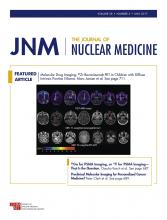Article Figures & Data
Tables
Parameter 68Ga 18F Half-life 68 min (less radiation burden to relatives [complete decay within a few hours after examination]; shippable only to close satellite centers) 110 min (satellite shipping possible; delayed imaging after longer incubation time possible) Positron energy 1.90 MeV (penetration depth of positron theoretically higher [most pronounced in lungs] but widely negligible in solid tissues using standard reconstruction algorithms and adjusted filtering) 0.65 MeV (lower radiation burden despite longer half-life; theoretically higher resolution) Labeling Chelator molecules (dedicated environment required, but kit formulation [one vial, room temperature] also possible) Prosthetic group molecules (dedicated environment required [hot cells, remotely controlled radiosynthesizers]) Theranostic approach One-molecule approach (radiolabeling with diagnostic [e.g., 68Ga] and therapeutic [e.g., 177Lu, 225A, 213Bi] radionuclides possible [PSMA-11 can be radiolabeled only with diagnostic radionuclide]) Tandem approach (different chemical structure of diagnostic and structurally related therapeutic tracer [e.g., PSMA-1007/PSMA-617, DCFPyl/MIP-1095]) Upfront investment and running costs Generators (∼50,000 USD/EUR, ∼2 generators per year); radiosynthesizer or kit production Cyclotron (∼1,000,000–3,000,000 USD/EUR); radiosynthesizers connected to cyclotron; 18O-water as target material per production run Scalability Defined generator capacity Production demand well scalable to adapt requested number of examinations







